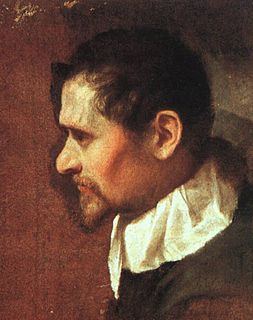Related Research Articles

Agostino Carracci was an Italian painter, printmaker, tapestry designer, and art teacher. He was, together with his brother, Annibale Carracci, and cousin, Ludovico Carracci, one of the founders of the Accademia degli Incamminati in Bologna. This teaching academy promoted the Carracci emphasized drawing from life. It promoted progressive tendencies in art and was a reaction to the Mannerist distortion of anatomy and space. The academy helped propel painters of the School of Bologna to prominence.

Annibale Carracci was an Italian painter and instructor, active in Bologna and later in Rome. Along with his brother and cousin, Annibale was one of the progenitors, if not founders of a leading strand of the Baroque style, borrowing from styles from both north and south of their native city, and aspiring for a return to classical monumentality, but adding a more vital dynamism. Painters working under Annibale at the gallery of the Palazzo Farnese would be highly influential in Roman painting for decades.

Guido Reni was an Italian painter of the Baroque period, although his works showed a classical manner, similar to Simon Vouet, Nicholas Poussin, and Philippe de Champaigne. He painted primarily religious works, but also mythological and allegorical subjects. Active in Rome, Naples, and his native Bologna, he became the dominant figure in the Bolognese School that emerged under the influence of the Carracci.

LudovicoCarracci was an Italian, early-Baroque painter, etcher, and printmaker born in Bologna. His works are characterized by a strong mood invoked by broad gestures and flickering light that create spiritual emotion and are credited with reinvigorating Italian art, especially fresco art, which was subsumed with formalistic Mannerism. He died in Bologna in 1619.

Domenico Zampieri, known by the diminutive Domenichino after his shortness, was an Italian Baroque painter of the Bolognese School of painters.

Francesco Albani or Albano was an Italian Baroque painter who was active in Bologna (1591–1600), Rome (1600–1609), Bologna (1609), Viterbo (1609–1610), Bologna (1610), Rome (1610–1617), Bologna (1618–1660), Mantova (1621–1622), Roma (1623–1625) and Florence (1633).

Giovanni Lanfranco was an Italian painter of the Baroque period.

Domenico Maria Canuti was an Italian painter of the Baroque period, active mainly in Bologna and Rome. He was a major painter of fresco decorations. His ceiling decorations showed a mix of Bolognese and Roman influences.

Pietro Faccini or Facini (1562–1602), was an Italian painter, draughtsman and printmaker. He was active near his birthplace of Bologna working in a style bridging Mannerism and the nascent Baroque.

Francesco Brizio (1574–1623) was an Italian painter and engraver of the Bolognese School, active in the early-Baroque.

Palazzo Magnani is a Renaissance palace located on Via Zamboni number 20 in central Bologna, region of Emilia Romagna, Italy, built by the Magnani noble family with the same name.

Italian Baroque art is a term that is used here to refer to Italian painting and sculpture in the Baroque manner executed over a period that extended from the late sixteenth to the mid eighteenth centuries.

Hunting is a painting by Italian artist Annibale Carracci, painted before 1595 and given to Louis XIV by Prince Camillo Pamphili in 1665. It is currently held and exhibited at the Louvre in Paris.

The Carracci were a Bolognese family of artists that played an instrumental role in bringing forth the Baroque style in painting. Brothers Annibale (1560–1609) and Agostino (1557–1602) along with their cousin Ludovico (1555–1619) worked collaboratively. The Carracci family left their legacy in art theory by starting a school for artists in 1582. The school was called the Accademia degli Incamminati, and its main focus was to oppose and challenge Mannerist artistic practices and principles in order to create a renewed art of naturalism and expressive persuasion.

Palazzo Fava or Palazzo Fava-Ghisilieri is a historic palace at 2 via Manzoni in Bologna, now housing art exhibitions and the Caffè Letterario Carracci Fava. It is most notable for its three rooms of frescoes of scenes from the lives of Jason, Medea, Europa and Aeneas by Ludovico Carracci, Agostino Carracci and Annibale Carracci, commissioned in 1584 by Filippo Fava - he was introduced to them by his tailor Antonio, Agostino and Annibale's father.

The Palazzo Sampieri frescoes are a set of paintings by Annibale, Agostino and Ludovico Carracci in the Palazzo Sampieri in Bologna. They form the last surviving collection of works by the three artists.

Christ and the Samaritan Woman or The Woman at the Well is a 1593-1594 oil on canvas painting by Annibale Carracci, painted as part of the same scheme as the Palazzo Sampieri frescoes. Several years later he also produced a much smaller autograph copy with variations, now in the Museum of Fine Arts, Budapest.

An Allegory of Truth and Time is a 1584-1585 oil on canvas painting by Annibale Carracci, now on display in Hampton Court as part of the Royal Collection.

Self-Portrait is a 1593 oil on canvas painting by Annibale Carracci, now in the Galleria Nazionale di Parma. It is dated 17 April 1593 on the top left of the canvas.

Entombment of Christ is a c.1595 oil on copper painting by Annibale Carracci, now in the Metropolitan Museum of Art
References
- ↑ Storia e Memoria di Bologna, by Daniela Sinigalliesi.